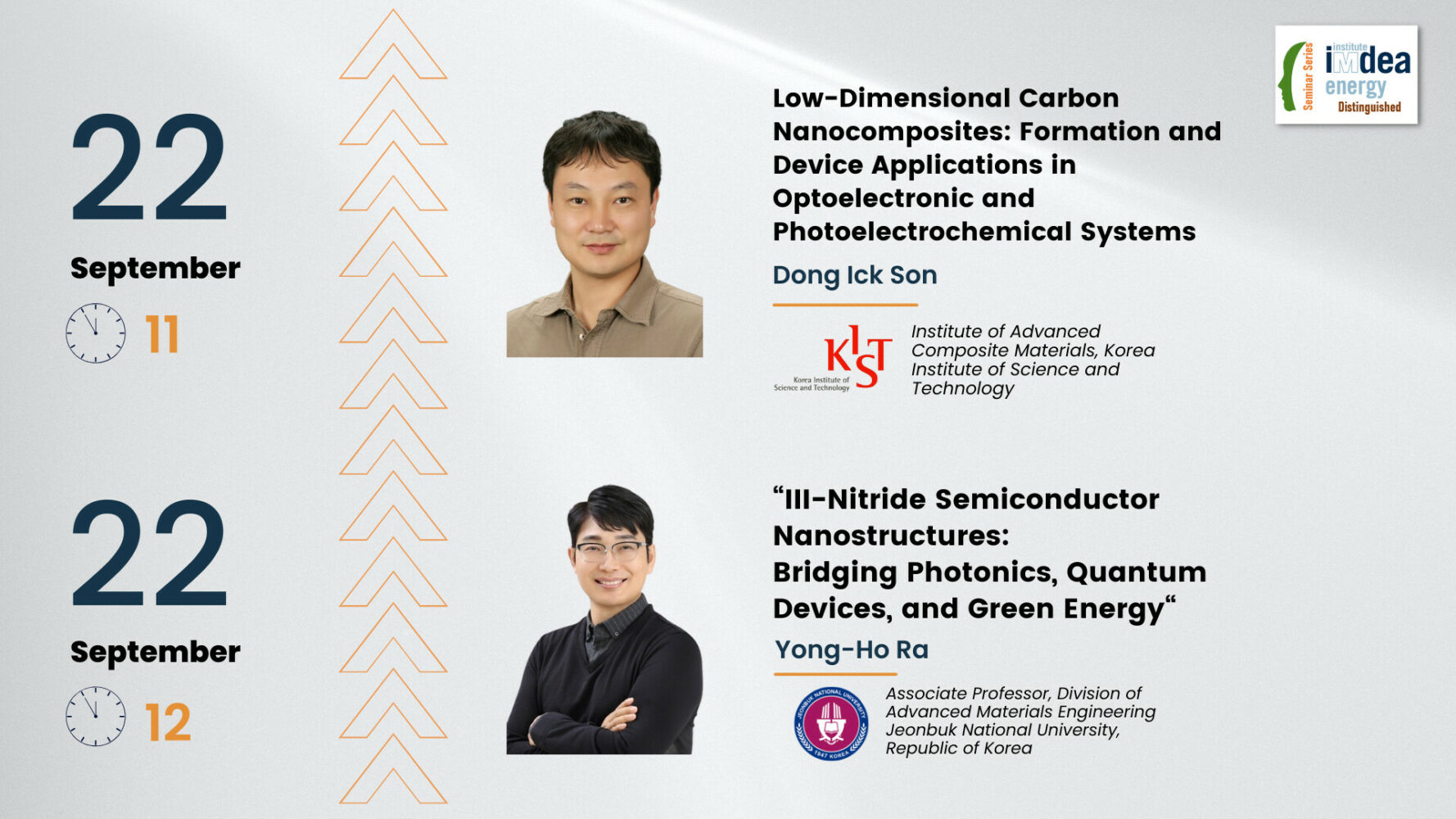Distinguished Seminar: «Low-Dimensional Carbon Nanocomposites» & « III-Nitride Semiconductor Nanostructures»

Bio
Dong Ick Son
Dr. Dong Ick Son earned his Ph.D. in Information Display Engineering from Hanyang University, Seoul, in 2010, and is currently Professor at Jeonbuk National University and Korea University of Science and Technology (UST), as well as Principal Research Scientist at the Korea Institute of Science and Technology (KIST) in Jeonbuk, where he has worked in various roles since 2011. His research focuses on the design, synthesis, and device fabrication of hybrid organic/inorganic nanocomposites for advanced optical and electronic applications, including nonvolatile memory, light-emitting devices, photodetectors, photoelectrochemical (PEC) cells, and photovoltaics. He has authored over 100 peer-reviewed publications, including Nature Nontechnology, and holds more than 60 domestic and international patents in electronic and energy device technologies.
Abstract
Low-Dimensional Carbon Nanocomposites: Formation and Device Applications in Optoelectronic and Photoelectrochemical Systems
Carbon nanomaterials such as carbon dots, fullerenes, carbon nanotubes (CNTs), and graphene have recently gained great interest due to their exceptional physical, chemical, and mechanical properties. These developments have opened new avenues in materials science, chemistry, and physics, while highlighting diverse and promising applications. Semiconductor quantum dots (QDs) in particular exhibit broad absorption ranges, high absorption coefficients, narrow emission spectral bandwidths, and tunable emission wavelengths through careful control of their composition and size.
Moreover, hybrid structures that integrate different dimensionalities – such ad 0D fullerenes, 1D CNTs, and 2D graphene – have revealed novel physical phenomena. Such low – dimensional nanocomposites are currently being advanced for applications ranging from light – emitting diodes (LEDs), photovoltaics, and sensors to PEC cells, batteries, memory devices, fuel cells, and biomedical systems.
This presentation introduces recent progress in the formation and device integration of low – dimensional nanocomposites, with a particular focus on their optoelectronic and photoelectrochemical applications.
Short bio
Yong-Ho Ra
Prof. Yong-Ho Ra is an Associate Professor in the Division of Advanced Materials Engineering at Jeonbuk National University (JBNU), Republic of Korea, where he also leads the Semiconductor Materials & Devices Laboratory (SMDL). He earned his B.S., M.S., and Ph.D. in Advanced Materials Engineering from JBNU and completed a postdoctoral fellowship at McGill University in the Department of Electrical & Computer Engineering. From 2018 to 2021, he was a Senior Researcher at the Korea Institute of Ceramic Engineering & Technology (KICET), contributing to optical and electronic component materials. His research focuses on the epitaxial growth and synthesis of III – nitride semiconductor nanostructures – including nanowires, nanorods, quantum dots, and thin films – using MOCVD and MBE, and on developing advanced optoelectronic and energy devices such ad LEDs, laser diodes, photodetectors, and photoelectrochemical cells for applications in micro/nano displays, AR/VR/XR, AI-based optical computing, and solar-driven water splitting and CO₂ reduction. Prof. Ra has published over 80 SCI-indexed articles in journals including Science Advances, Nano Letters, and Advanced Functional Materials, and holds more than 50 patents, including 8 U.S. patents, on nitride nanostructure devices.
Abstract
III-Nitride Semiconductor Nanostructures: Bridging Photonics, Quantum Devices, and Green Energy
III-nitride (GaN, AlN, InN, and their alloys) semiconductor nanostructures, such as nanowires and nanorods, provide a versatile platform that bridges fundamental materials science and advanced device applications. Their unique properties, including defect suppression, strain relaxation, and wide bandgap tunability, enable novel functionalities beyond conventional thin – film technologies. Our group has pioneered world -first demonstrations such as epitaxy – driven full – color nanorod micro -LED pixels and electrically pumped photonic crystal nanorod lasers, establishing III – nitrides as key enablers as key enablers for next – generation display and optoelectronic devices.
This presentation highlights recent advances in the epitaxial growth of III – nitride nanostructures using MOCVD and MBE, emphasizing precise composition control heterostructure design, and device integration. Applications include high – performance LEDs. Low – threshold nanorod lasers, and photodetectors with enhanced sensitivity, extending toward AR/VR/XR displays and ultra – compact light sources. III – nitride nanostructures also show great potential in green energy applications, including solar – driven water splitting for hydrogen generation and photocatalytic CO₂ reduction, demonstrating their broader societal impact.
Emerging directions, such as quantum – photonic devices and AI – driven transceivers, suggest that III – nitride nanostructures could play a transformative role in photonics, energy, and quantum information technologies, bringing fundamental science and practical applications for the next generation of optoelectronic systems.
-
00
days
-
00
hours
-
00
minutes
-
00
seconds


